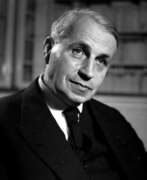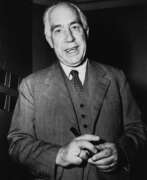Philosophers 20th century
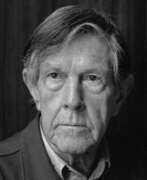

John Milton Cage Jr. is an American composer, philosopher, poet, musicologist, and artist. Cage is considered one of the leading figures of the post-war avant-garde.
Born in the United States, he studied architecture in Europe, but music and painting seemed more interesting to him and he has achieved impressive success there. John Cage is considered a pioneer of uncertainty in music and the unconventional use of instruments, and is highly regarded for his paintings and prints. In addition, he played a crucial role in the development of modern dance and performance art.
His father John Milton Cage (1886-1964) was an inventor.


Gino De Dominicis was an Italian artist.
Controversial protagonist of Italian art after the Second World War, he used various techniques and defined himself as a painter, sculptor, philosopher and architect. His work tends to become independent of both fashions and neo-avant-garde groups. Therefore, it cannot be framed in a specific artistic current: neither in Arte Povera, nor in the Transavanguardia, nor in the conceptual art, which rejected.


Antoine Marie Jean-Baptiste Roger, Comte de Saint-Exupéry, known as Antoine de Saint-Exupéry, is a French national treasure who seamlessly combined his profession as an aviator with his literary genius. Known for "The Little Prince," he masterfully blended philosophy and poetic discourse into narrative forms. This author, journalist, and pioneering pilot left an indelible mark through his literary works and contributions to aviation.
Saint-Exupéry's merits transcend his inventive storytelling; his narratives often reflect his aviation experiences, offering unique insights into humanity and technology's intersection. His works, though not housed as traditional art in museums, reside in the Louvre of public imagination and literary canon.
For enthusiasts and experts, Saint-Exupéry's legacy is a testament to the enduring power of human spirit and curiosity. His narrative sculptures crafted from words, deeply philosophical and yet whimsically accessible, continue to inspire and resonate. Dive into the world of this exceptional storyteller and aviator to explore the skies of human experience.


Pedro Figari was a Uruguayan painter, lawyer, writer, and politician. Although he did not begin the practice until his later years, he is best known as an early modernist painter who emphasized capturing the everyday aspects of life in his work. In most of his pieces, he attempts to capture the essence of his home by painting local customs that he had observed in his childhood.
Figari painted primarily from memory, a technique that gives his work a far more personal feeling. With his unique style, which involved painting without the intention to create an illusion, he, along with other prominent Latin-American artists such as Diego Rivera and Tarsila do Amaral, sparked a revolution of identity in the art world of Latin America.


Giandante X, birth name Dante Pescò, was an Italian painter, sculptor, illustrator, poet and philosopher.
Giandante X's artistic style was characterised by abstraction and expressiveness. He used bold and bright colours, dynamic lines and textures to convey his artistic vision. His work often conveyed a sense of movement and energy, inviting viewers to emotionally and intellectually engage with the piece.
Throughout his artistic career, Jandante X addressed a wide range of themes and concepts. He drew inspiration from a variety of sources including mythology, spirituality and the human condition. His works often addressed existential questions, social issues, and the interaction between man and society.


Albert Gleizes was a pioneering French artist, theoretician, and philosopher, renowned for his contributions to Cubism and his influence on the School of Paris. Born in Paris in 1881, Gleizes' artistic journey began in his late teens, inspired by Impressionism and later evolving through Post-Impressionist and Symbolist phases. His early work, such as "La Seine à Asnières" exhibited in 1902, showcases his initial foray into painting. Gleizes' commitment to developing art free from commercial constraints led him to co-found the Abbaye de Créteil, a self-supporting artist community, although it was short-lived due to financial difficulties.
Gleizes' exploration of Cubism began around 1910, in collaboration with artists like Jean Metzinger, with whom he wrote "Du Cubisme," the first major treatise on the movement. This period marked a significant shift in his style towards the geometric simplification of forms, a hallmark of Cubism. His works from this era, including "Portrait de Jacques Nayral" and "Landschaft bei Paris," exemplify his innovative approach to capturing the essence of subjects through cubist principles. Gleizes was also a member of the Section d'Or group, further establishing his role in the Cubist movement.
In addition to his painting, Gleizes was deeply involved in writing and promoting Cubism, influencing the acceptance and understanding of modern art globally, including his significant impact in New York. His later works, such as "Pour Contemplation," reflect a spiritual and theological depth, moving towards a synthesis of the physical and metaphysical. Gleizes' art is celebrated for its revolutionary approach to form and color, contributing significantly to the development of modern art. His works are held in prestigious collections worldwide, including the Tate Modern and the Musée des Beaux-Arts in Lyon.
For those intrigued by the revolutionary spirit and profound impact of Albert Gleizes on modern art, signing up for updates on new product sales and auction events related to his work offers a unique opportunity to connect with the legacy of this Cubist master. This subscription is an invaluable resource for collectors and experts in art and antiques, promising exclusive insights into the world of Albert Gleizes.


Kazimir Severinovich Malevich (Russian: Казимир Северинович Малевич) was a pioneering Russian artist, known for his profound influence on the development of abstract art in the 20th century. His nationality and specializations in painting, art theory, and teaching have cemented his place as a pivotal figure in the avant-garde movement, particularly for his role in founding the Suprematism movement. This movement, characterized by its focus on basic geometric shapes and a limited color palette, aimed to convey the supremacy of pure artistic feeling over the depiction of objects.
Malevich's art and theories have had a lasting impact on the course of modern art, challenging traditional perceptions of form and composition. His most famous work, "Black Square," epitomizes the essence of Suprematism. It represents a radical break from past art forms and a move towards abstraction, where the emotional and spiritual dimensions of art are prioritized. This piece, along with others like "White on White," has been exhibited in prestigious museums and galleries worldwide, showcasing Malevich's enduring legacy.
For collectors and experts in art and antiques, Malevich's works are not just paintings but are significant historical artifacts that embody a transformative period in art history. His contributions extend beyond his canvases, influencing sculpture, culture, and the broader artist school. His innovative approach to art has paved the way for future generations of artists, making his works highly sought after in the art and antique collecting community.
For those interested in the avant-garde movement and the evolution of abstract art, staying informed about Kazimir Malevich's contributions is essential. We invite you to sign up for updates related to Malevich, including notifications on new product sales and auction events. This subscription will keep you at the forefront of the latest discoveries and opportunities to acquire pieces connected to this revolutionary artist.


Nikolai Konstantinovich Roerich (Russian: Никола́й Константи́нович Ре́рих) was a distinguished Russian artist, writer, archaeologist, and philosopher, renowned for his profound contributions to culture and art. His multifaceted career spanned various disciplines, but it was his exceptional talent in painting that immortalized his name among the greats. Roerich's art is celebrated for its mystical and symbolic themes, often drawing inspiration from Russian folklore, religion, and his own spiritual quests. His dedication to cultural preservation and peace through art led to the establishment of the Roerich Pact, a treaty advocating for the protection of cultural heritage.
Roerich's paintings are characterized by vibrant colors and intricate details, capturing the ethereal beauty of landscapes and mythical scenes. His works, such as "Madonna Laboris" and the series "Sancta," are revered for their spiritual depth and artistic excellence. These masterpieces can be found in prestigious museums and galleries worldwide, serving as testaments to Roerich's enduring legacy in the art world. His commitment to integrating spiritual and cultural dimensions in his art has made him a seminal figure for collectors and experts in art and antiques.
Roerich's influence extends beyond his paintings; his philosophical writings and cultural initiatives have also left a significant mark on the fields of art and heritage preservation. As enthusiasts of art and antiquities continue to explore Roerich's rich legacy, there is a growing appreciation for his vision of unity and harmony through cultural expression. For those captivated by Roerich's remarkable life and works, signing up for updates is an invaluable opportunity to stay informed about new product sales and auction events dedicated to his art. This subscription is a gateway to exclusive insights and offerings that celebrate the legacy of Nikolai Konstantinovich Roerich, ensuring enthusiasts remain connected to the evolving exploration of his profound contributions.


Rabindranath Tagore was a South Asian Bengali polymath who worked as a poet, writer, playwright, composer, philosopher, social reformer and painter. He reshaped Bengali literature and music as well as Indian art with Contextual Modernism in the late 19th and early 20th centuries. Author of the "profoundly sensitive, fresh and beautiful" poetry of Gitanjali, he became in 1913 the first non-European and the first lyricist to win the Nobel Prize in Literature. Tagore's poetic songs were viewed as spiritual and mercurial; however, his "elegant prose and magical poetry" remain largely unknown outside Bengal. He was a fellow of the Royal Asiatic Society. Referred to as "the Bard of Bengal", Tagore was known by sobriquets: Gurudev, Kobiguru, Biswakobi.
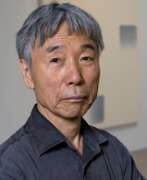

Lee Ufan is a Korean-Japanese artist. He is a leading figure of the Mono-ha movement, which emerged in Japan in the late 1960s and emphasized the relationships between natural and industrial materials, space, and perception.
Lee Ufan moved to Japan in 1956 and studied philosophy at Nihon University in Tokyo. In the late 1960s, he began to create minimalist sculptures and installations that explored the interactions between natural and industrial materials such as stone, metal, and glass.
In addition to his work as a visual artist, Lee Ufan is also a noted writer and philosopher. He has written extensively on aesthetics, contemporary art, and Zen Buddhism.
Lee Ufan's work has been exhibited in major museums and galleries around the world, including the Guggenheim Museum in New York, the Centre Georges Pompidou in Paris, and the National Museum of Modern and Contemporary Art in Seoul. He has also been the subject of several major retrospectives, including exhibitions at the Solomon R. Guggenheim Museum in New York in 2011 and the Centre Pompidou in Paris in 2014.
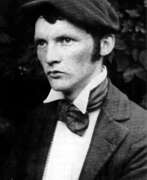

Heinrich Vogeler was a German artist and philosopher, a representative of the German Art Nouveau. A versatile and talented artist, he painted, watercolored, composed poems, designed, designed and decorated. Over time, his style of art changed over a wide range.
During World War I, from 1914 to 1917, Vogeler was on the Eastern Front as a volunteer and made sketches, which resulted in his pacifist sentiments.
In the mid-1920s he visited the Soviet Union several times and his impressions resulted in paintings in his own "complex style: "Karelia and Murmansk" (1926), "Building a New Life in the Soviet Republics of Central Asia" (1927), and "Baku" (1927). In 1931 Vogeler received an invitation to work in the USSR. The coming to power of the Nazis in Germany made it impossible for him to return home, and after Hitler's invasion Vogeler among many was deported to the Kazakh SSR, where he died.


Julia Ward Howe is an American writer and poet, philosopher, abolitionist, and feminist.
Born into a well-to-do family and privately educated, Julia Ward married educator Samuel Gridley Howe and settled in Boston. She published her first collection of poems, Passionate Flowers, in 1854.Julia's early poems were praised by Hawthorne, Whittier, and Longfellow for their intellectual intensity. For a time Howe published the abolitionist newspaper Commonwealth with her husband. And in February 1862, The Atlantic Monthly published her poem "Battle Hymn of the Republic," which became the semi-official Civil War song of the Union Army, and Howe gained fame.
After the war, Howe began fighting for women's rights. In 1868, she was elected the first president of the New England Women's Suffrage Association. In 1868, she helped found the New England Woman's Club and became its president in 1871, the same year she became the first president of the American branch of the International Women's Peace Association. She was later active in the International Federation of Women's Clubs. Howe continued to write throughout her life, publishing travel books, poems, collections of essays, and biographies.
In 1870, she co-founded Woman's Journal and then served as its editor for 20 years. She traveled extensively until her advanced old age. In 1908, she became the first woman elected to the American Academy of Arts and Letters.


